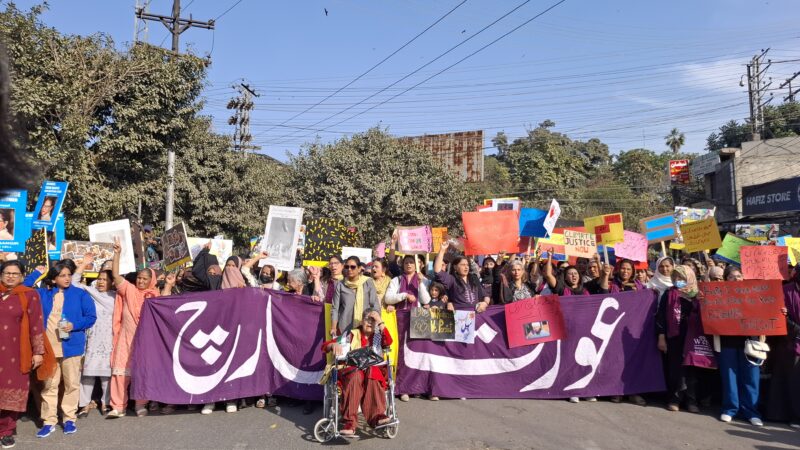Aurat March 2025. Image by the author. Used with permission.
This year’s Aurat March, an annual socio-political demonstration across Pakistan, occurred on February 12 in alignment with National Women’s Day. The theme “Feminist History” was chosen to celebrate the courageous women who fought against the oppressive laws of military ruler General Zia-ul-Haq during the 1980s.
Prior to the march, the Women’s Action Forum (WAF) and Aurat March convened a joint press conference at the Lahore Press Club, where they unveiled a 14-point charter of demands emphasizing pressing issues like gender-based violence, severe censorship laws, and the recent amendment to the Pakistan Electronic Crimes Act 2025 (PECA).
Unyielding in the face of resistance
For the past six years, the Aurat March has taken place on March 8, International Women’s Day, organized by the feminist collective Hum Aurtein. The event aims to raise awareness against patriarchal norms and advocate for the rights of women and marginalized communities in Pakistan. However, it has consistently encountered backlash from authorities and religious factions. This year, women could only proceed with their march after the Lahore High Court mandated the district administration to ensure its success.
Leena Ghani, an artist and activist, shared insights with Global Voices via WhatsApp regarding the initial indifference of authorities towards the Aurat March:
In the first two years, the Aurat March was not perceived as a threat. However, after 2020, the state recognized our strength and accused us of promoting vulgarity. The slogan ‘Mera Jism Meri Marzi’ (my body, my choice) evoked significant backlash, yet the Aurat March took control of the narrative and engaged legally, as this became a strategy for the state to intimidate us.
This year, the Aurat March will be celebrated over two months on various dates. The Lahore chapter opted for an earlier date due to the beginning of Ramadan, during which many women find it challenging to participate.
Other chapters will hold their events on these dates: Aurat March Multan on February 23, Aurat March Islamabad on March 8 (International Women’s Day), and Aurat Marches in Karachi and Mirpurkhas on May 11 (Mother’s Day).
Feminist history in Pakistan:
The Women’s Action Forum (WAF) has served as a pivotal platform for advocacy and activism since its inception in 1981.
Nighat Said Khan, a feminist activist, communicated through WhatsApp with Global Voices about WAF’s long-standing influence:
WAF has been commemorating this occasion since 1984, with various organizations joining in organically over the years. Although not officially recognized by the government, it holds significant meaning and continues to be celebrated.
This year’s theme reflected on the Feminist History of Pakistan, commemorating the women who bravely protested against General Zia-ul-Haq’s military dictatorship on February 12, 1983, despite martial law restrictions banning public demonstrations. This protest was in response to the proposed Law of Evidence, which aimed to diminish the value of women’s testimony. This moment symbolizes the relentless pursuit of a gender-just democratic order advocating for universal human rights, particularly for marginalized groups.
Marchers, placards, and performances:
The inclusive nature of the march attracted individuals of all genders and ages. Nighat Said Khan led the march from a wheelchair, exemplifying resilience and inspiring younger feminists.
Despite this, there has been a noticeable decline in participation over the years, sparking concern about the march’s momentum. Nida Kirmani, an associate professor at Lahore University of Management Sciences, expressed her thoughts on Facebook:
This is termed the routinization of protest, common in many movements. For a movement to thrive, it must consistently mobilize around pressing issues that resonate with a broad audience.
Conversely, Asma Amir, a women’s rights activist, contested this view while speaking to Global Voices on WhatsApp:
The declining numbers result from various factors, including alienating slogans, institutional barriers, and a polarized public discourse focused on sensationalism rather than substantive demands. Nevertheless, the march’s essence lies in its symbolic resistance; small, dedicated groups can ignite broader social change, even if progress seems gradual.
This year’s slogans prominently addressed inheritance rights, ending enforced disappearances, gender-based violence, sexual abuse, and climate change. A notable placard was held by Maria Butt, a figure in the fashion industry, who faced criticism for past transphobic statements.
Upon reaching their destination, speeches were delivered emphasizing various feminist movements laboring quietly in Pakistan. Ajoka Theatre performed a dance, energizing the crowd with revolutionary songs.
Art Installations:
To highlight everyday struggles faced by women due to patriarchal systems, the Aurat March introduced innovative art installations. A voting booth allowed marchers to select statements they often hear, expressing their personal experiences.

Image by the author. Used with permission.
A phone was also available, showcasing recordings of women who wished to participate but could not due to familial pressures.

Wall of Rage. Image by the author. Used with permission.
Another installation was the Wall of Rage, where participants could express their feelings through art. Statements such as “My Body, My Choice”, “Me Too”, and “Proud to Be Transgender” were visible by the march’s conclusion.

Purple sheet of hope. Image by the author. Used with permission.
Marchers also displayed a purple chaddar (sheet) of hope, symbolizing dreams of empowerment and change for women’s lives. Another sheet highlighted stories of harassment endured by women across generations.
Social media influencers and YouTubers:
In recent years, YouTube influencers have portrayed the march negatively, often harassing participants online. This year, due to prior experiences, many marchers were hesitant to engage with media representatives.
Asma Amir conveyed to Global Voices via WhatsApp:
To combat negative narratives, marchers reported YouTubers, and with police assistance, direct access to them was minimized. However, creators continue to exploit footage from afar to perpetuate a misleading narrative. The repetitive use of controversial slogans like “Mera Jism Meri Marzi” by media outlets drives backlash through sensationalism, overshadowing crucial demands like the abolition of child marriage and combating gender-based violence. This misrepresentation diverts attention from systemic issues toward divisive rhetoric.


